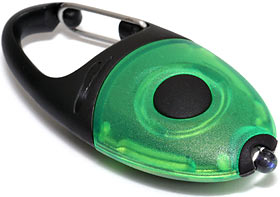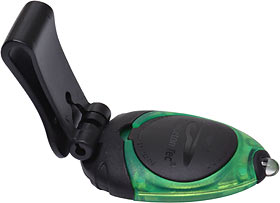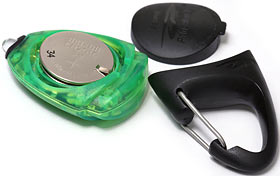
Quick Shot review 17:
Princeton Tec Eclipse 2 LED flashlight
Review date: 18 February 2004.
Last modified
03-Dec-2011.
Everybody needs a key-ring flashlight. If you think you don't, then do me a favour; go to your local flea market, find someone selling hyper-cheap Photon knock-offs, buy one for less than the price of a cup of very bad coffee, clip it onto your keys, and then see how often you end up using it. You'll probably be surprised.
Super-cheap tiny-lights can't be expected to survive abuse like a name-brand tiny-light, but never mind the quality, feel the price.
If you want a tiny-light with respectable battery life, then no tiny-light - they're generally the size of a large wad of chewing gum - will do. You'll need something that takes a AAA or maybe even AA cell. I review a couple of excellent candidates here.
But if you only expect to need to light stuff up for a few seconds at a time, as you navigate the side path at night, try to find a keyhole, search for things that fell down the back of your desk or perform other everyday small-flashlight tasks, then a tiny-light most definitely will do, and its batteries may well last for years. The lithium coin cells these things all run from have miserable capacity compared with even a AAA cell, but their shelf life is huge.
Because tiny-lights are so useful, there are zillions of different models of them out there. I've reviewed a few of them (here, here, here, here, here and here, if you must know).
And here's another one.
Princeton Tec's Eclipse 2 is, thankfully, Not Just Another Key-Ring Light. It's got the same basic layout - 5mm LED on the end, button on the top, couple of CR2016 lithium cells inside - as umpteen others, but it has some tricks up its sleeve.
The Eclipse 2 is chunkier than many key-ring lights. It's almost 70mm long, and weighs an elephantine 12.5 grams, versus the sub-40mm body length and sub-10 gram weight of a Photon Micro-Light with key-ring attached. But the Princeton Tec light is still hardly going to be a burden for anybody more than a few inches tall.
I got this Eclipse 2 from discount light emporium Flashlights 4 Less, who sell it for only $US11.95 ex shipping. For a light with this one's feature list, that's a great price.
Australians who feel like buying an Eclipse 2 from Flashlights 4 Less can do so, but international shipping means it won't be great value unless you buy a few. They'll ship up to four Eclipse 2s to Australia for $US14.50 by air mail, or for $US20.50 by Global Express Mail.
As I write this, their shopping cart software hasn't quite caught up with this pricing, which means people are signing on for an "estimated" $US24 shipping and then getting a pleasant surprise when they see their credit card bill.
In standard trim, the Eclipse 2 attaches to your key-ring, or various other things, with a little spring carabiner. This is much easier to disconnect than the normal cheap split ring connector, so you can snap the light onto your keys, backpack harness, neck lanyard or what-have-you and easily turn it into an unencumbered hand-light when needed.
But there's more. A hefty tug will separate the black carabiner section from the translucent front of the Eclipse 2...
...allowing you to attach this hinging clip instead. Now, the light can be attached to a hat brim, belt or anything else not more than about 5mm thick, and aimed freely up and down. The clip also sits pretty stably on the ground, which lets you aim the light anywhere from horizontally to almost straight up without it falling over.
A single LED running from coin cells isn't much of a work light, but it's a heck of a lot better than nothing when you're changing a wheel at night in the rain.
If you want to use a regular key-ring light as a work light, you almost always end up having to hold it in your mouth. And bite down on it, if it's a momentary-switch "squeeze light" type.
The Eclipse 2 is not a simple squeeze light. It's a singing-and-dancing dimmable chip-controlled light, like unto the Photon 3 I review here, but with fewer modes. Which is not necessarily a bad thing.
Turn the Eclipse 2 on with a press on its button and you get full brightness mode. A very respectable full brightness mode, too; from fresh batteries the Eclipse 2 drives its white LED at least as hard as any other tiny-light I've seen.
If you tap the button again within 1.5 seconds of turning the light on, you'll get medium brightness, and another tap gives you low brightness. Next there's a slow flash mode, giving full-brightness pulses every two seconds, then a faster flash mode, then the light turns off. If you wait more than two seconds after selecting any mode, tapping the button will turn the Eclipse off. Holding the button down for more than a moment will do the same thing.
All of the Eclipse 2's modes except the full-power one are actually flashing modes; like most dimmable LED lights, the Eclipse 2 dims by flashing its LED very quickly. The flash speed's fast enough that you'll need to be shining the light at a fan or waving it around to notice any significant flicker, though.
Power
Removing the Eclipse's clip or carabiner makes it easier to lever out the press-fit battery bay cover. Inside, the two lithium cells are lightly retained by a pleasingly un-fussy contact-clip. It's possible that you'll strain that clip as you replace the cells, and end up with an intermittent contact, but it's easy to just push the clip back down to get solid operation again. This is not one of those annoying tiny-lights that can be buggered up forever by a clumsy battery change.
The battery cover, by the way, has no O-ring waterproofing seal. The original Eclipse is advertised as "fully waterproof", but Princeton Tec make no such statement about the Eclipse 2 - though various dealers do. The Eclipse 2 is not, actually, a properly waterproof light, but it will survive pretty much anything short of prolonged immersion. I don't think any amount of rain is likely to faze it, and a soaking with water-repellent spray and/or silicone grease would probably "tropicalize" the Eclipse 2 quite effectively.
Cavers might should note that the Eclipse 2 does not float. If you drop it in a bottomless inky pool, it'll just DiCaprio away into the depths.
I stuck a multimeter in-line with the Eclipse 2's batteries, to see about how much juice it drew. Even through the multimeter (whose own resistance skews the results downwards), the light drew about 80 milliamps (mA) in full power mode. Actually, it briefly sucked about 90mA, before the 2016 cells sagged, shrieking thinly, to the lower current figure.
80mA is a quite horrendous load for CR2016 cells, which were created to supply microamps to things like wristwatches. As I've said in my previous tiny-light reviews, though, the current drawn falls as the batteries fade, and the result of that can be very long battery life, provided you don't mind most of that life giving you a lot less brightness than that first amazing blast from your new tiny toy.
At the medium and low brightness settings (even low mode is brighter than some of the crummier tiny-lights I've seen), the Eclipse 2 drew around 40 and 20mA, respectively. Still a lot to ask from coin cells, but certain to give much greater battery life improvements than simple mathematics would suggest. The lower the load, the more capacity you'll get out of the batteries.
The Eclipse 2 beam is unremarkable for a mid-priced tiny-light like this. There's lots of blue in the white light, as is normal for less-than-top-grade white LEDs and even for better LEDs when they're driven as hard as this one is. The useful beam width is in the vicinity of 45 degrees (depending on how much of the side-spill light you deem "useful"), which is what you want for a close-range walking-around light like this.
I also noted that the Eclipse 2 lights up, faintly, even when it's powered by only one of its batteries. This is good news for people who find themselves stuck in a cave with it; despite the fact that this is a fancy "smart" light, you'll still get better-than-nothing-at-all output from it even if its batteries are miserably flat. And if you wanted to convert the Eclipse 2 into a super-long-life, very-low-output light, you could swap a single CR2032 (20mm diameter, 3.2mm thickness) in place of the two CR2016s (same diameter, 1.6mm thick).
The Eclipse 2 comes in versions with white, blue, green and red LEDs (Flashlights 4 Less only sell the white-LED version, as I write this). The blue model probably works pretty much exactly the same as the white one (because white LEDs are blue LEDs, with an extra phosphor layer over the blue die); the red model probably runs from a CR2032 and gets rather better battery life.
Overall
The world's well populated with cookie-cutter tiny-lights. Princeton Tec have contributed a couple themselves. The Eclipse 2 is genuinely different, though - more flexible, easy to use, eminently suitable for use in the city and the wilderness, and not too pricey, either.
Recommended.
Review Eclipse 2 kindly provided by Flashlights 4 Less.





